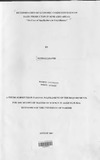| dc.description.abstract | This study was carried out in Kitui district in the year 2005 with the broad objective of
determining the economic competitiveness of dairy production. In this study, the
competitiveness of dairy production was assessed based on the contribution of the enterprise
to total farm income and returns to land and capital resources.
Data were collected from dairy farmers and categorized into small, medium and large farms
based on farm sizes. Gross margin, linear programming model and descriptive methods were
used to analyse the data. Results of descriptive analysis revealed that the average farm size in
the small, medium and large farm categories was 1.80 hectares, 4.90 hectares and 10.00
hectares respectively. The small farm category had 88% of the farmers who keep one or two
dairy cows besides growing maize, beans, and pigeon peas for subsistence and commercial
purpose. These results indicate that majority of the farmers within the area surveyed are
smallholder producers.
Results of gross margin analysis showed that under the existing small, medium and farm
plans, farmers earned Ksh 82,031 Ksh 91,844 and Ksh 109,075 respectively. The dairy
enterprise contributes 61% to total farm income in the small farms while in the medium and
large farms it contributes 71% and 59% respectively. The gross margins per hectare of the
dairy enterprise in the small farms was estimated at Ksh 174,996 compared to Ksh 6,865 and
Ksh 16,697 for maize/beans intercrop and beans respectively both produced during the short
rain season. In the small farms, the return to operating capital from the dairy enterprise was
Ksh 4.42 while it was Kshl.41 and Ksh 3.54 for maize/beans intercrop and beans
respectively. On the basis of enterprise contribution to total farm income, returns to land and
capital it can be concluded that dairy production in Kitui district is profitable and competitive
compared to crop production
Linear programming model was used to develop optimal farm plans with and without a
subsistence constraint and to identify limiting resources to agricultural production. Results of
linear programming analysis revealed that the optimal farm plans had few crop enterprises
compared to the existing farm plans. The dairy enterprise was included in the optimal plans
of the small and medium farms while it was excluded from the optimal plan ofthe large farm.
The optimal plans developed from a linear programming model without subsistence
constraints suggests that farmers with small, medium and large farms could earn Ksh
108,498, Ksh 107,004 and Ksh 158,807 respectively. Results of the linear programming
model with subsistence constraints established that farmers with small, medium and large
farms could earn Ksh 72,437, Ksh 69,978 and Ksh 137,253 respectively. The results show
that farm plans developed from a linear programming model without subsistence constraints
have higher income compared to the plans developed with the subsistence constraint.
Land and operating capital were found to be the most limiting resources in the small and
medium farm categories. Labour was found to be a non- limiting resource in all the farm
categories. Since land is a limiting resource farmers could improve farm income by
producing few profitable crop enterprises (beans, maize and maize/pigeon peas intercrop) and
keep one or two dairy cows under zero grazing production system. | en |

